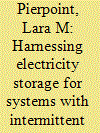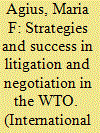|
|
|
Sort Order |
|
|
|
Items / Page
|
|
|
|
|
|
|
| Srl | Item |
| 1 |
ID:
088034


|
|
|
|
|
| Publication |
2009.
|
| Summary/Abstract |
This paper presents an hourly management method for energy generated in grid-connected wind farms using battery storage (Wind-Batteries systems). The method proposed is analysed technically and economically.
Electricity generation in wind farms does not usually coincide with the electrical demand curve. If the wind-power penetration becomes high in the Spanish electrical grid, energy management will become necessary for some wind farms. A method is proposed in this paper to adjust the generation curve to the demand curve by storing electrical energy in batteries during off-peak hours (low demand) and selling stored energy to the grid during peak hours (high demand).
With the results obtained and reported in this paper, for a Wind-Batteries system to be economically as profitable as a Wind-Only system, the selling price of the energy provided by the batteries during peak hours should be between 22 and 66 c€/kWh, depending on the technology and cost of the batteries. Comparison with flexible thermal generation has been performed.
Additionally, the results are compared with those obtained if using hydrogen (Wind-Hydrogen system, which uses an electrolyser, hydrogen tank, and fuel cell instead of batteries), concluding that the Wind-Batteries system is both economically and energetically far more suitable.
|
|
|
|
|
|
|
|
|
|
|
|
|
|
|
|
| 2 |
ID:
088035


|
|
|
|
|
| Publication |
2009.
|
| Summary/Abstract |
This paper presents an hourly management method for energy generated in grid-connected wind farms using battery storage (Wind-Batteries systems). The method proposed is analysed technically and economically.
Electricity generation in wind farms does not usually coincide with the electrical demand curve. If the wind-power penetration becomes high in the Spanish electrical grid, energy management will become necessary for some wind farms. A method is proposed in this paper to adjust the generation curve to the demand curve by storing electrical energy in batteries during off-peak hours (low demand) and selling stored energy to the grid during peak hours (high demand).
With the results obtained and reported in this paper, for a Wind-Batteries system to be economically as profitable as a Wind-Only system, the selling price of the energy provided by the batteries during peak hours should be between 22 and 66 c€/kWh, depending on the technology and cost of the batteries. Comparison with flexible thermal generation has been performed.
Additionally, the results are compared with those obtained if using hydrogen (Wind-Hydrogen system, which uses an electrolyser, hydrogen tank, and fuel cell instead of batteries), concluding that the Wind-Batteries system is both economically and energetically far more suitable.
|
|
|
|
|
|
|
|
|
|
|
|
|
|
|
|
| 3 |
ID:
149954


|
|
|
|
|
| Summary/Abstract |
A central challenge for grid operators is matching electricity supply to demand, especially when the electricity supply is composed in part of intermittent resources. Several system options could help balance electricity supply and demand given different mixes of intermittent, baseload and load-following generation capacity; of these, electricity storage is especially interesting. If electricity storage could be deployed widely, grids of any size could sustain a wide range of profiles of intermittent and baseload power. Currently, most installed electricity storage worldwide is pumped hydro. Flywheels, compressed air and batteries represent interesting technologies that could provide grid-scale storage, especially if technology costs come down. A significant amount of storage R&D worldwide is appropriately focused on lowering these costs, but more is needed. Ultimately, storage will only achieve high levels of penetration if it can compete for service provision in electricity markets, and policy adjustments are needed in many countries to ensure this is the case.
|
|
|
|
|
|
|
|
|
|
|
|
|
|
|
|
| 4 |
ID:
192807


|
|
|
|
|
| Summary/Abstract |
Grid-connected photovoltaic (PV) facilities are more attractive than ever due to the electricity price surges and the reduction of solar energy generation costs. This paper develops a solving procedure including a simulation model to analyze the techno-economic performance of PV-battery facilities, taking into account the latest Spanish regulatory framework. The procedure finds the best facilities for multiple objectives, maximum profitability and maximum self-sufficiency, in different locations, load profiles and economic scenarios. The results indicate that PV modules are profitable without subsidies, with installations between 1 and 6 kWp. Meanwhile, batteries are only convenient when seeking maximum independence from the grid, with capacities up to 9 kWh. The findings suggest that the economic feasibility of facilities is influenced by the location and compensation rate surplus electricity, while the facility is mainly determined by the load profile. A sensitivity analysis shows that a variation in grid tariffs and technology prices has a limited impact on the facility's size but modifies the system's profitability. Finally, an analysis of the latest unprecedented grid price surges indicates that self-consumption facilities help become a more resilient society against unexpected events. Therefore, policymakers should keep promoting the adoption of these technologies and keep the current advantageous regulations.
|
|
|
|
|
|
|
|
|
|
|
|
|
|
|
|
| 5 |
ID:
113960


|
|
|
|
|
| Publication |
2012.
|
| Summary/Abstract |
This article analyzes linkages between litigation in the World Trade Organization (WTO) Dispute Settlement Body (DSB) and negotiation in multilateral trade rounds and develops a typology of links that can occur between the two processes. These include creating conditions where bargaining is informed by law, influencing the agenda-setting and creating momentum for negotiation on key issues, and affecting the status quo from which negotiations proceed by influencing interpretation of trade rules in the DSB. The purpose is to test whether poor and inexperienced states that are disadvantaged in negotiations can improve their bargaining power in negotiation rounds by pursuing legal proceedings, to see whether links can be exploited for strategy-making to promote the interests of these states, and to discuss how the WTO as an international organization benefits from their empowerment. The strategies suggested in this article could improve the commitment and active participation of relatively non-influential member states. This could be conducive to perceptions of the WTO as a legitimate organization and to a more constructive climate for effective negotiations.
|
|
|
|
|
|
|
|
|
|
|
|
|
|
|
|
|
|
|
|
|